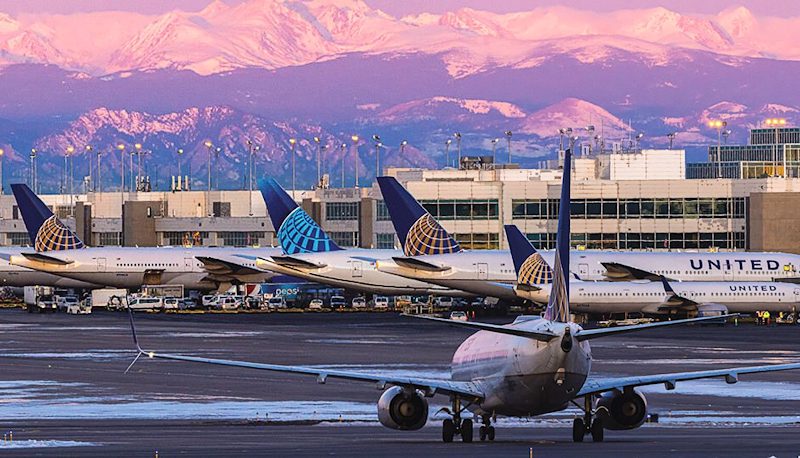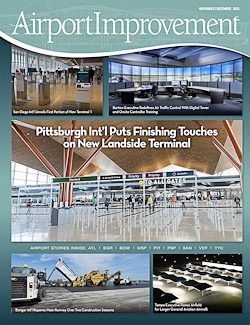For more than a decade, Denver International Airport (DEN) has been developing its Safety Management System (SMS) Manual to comply with the FAA Safety Organization’s ruling for Part 139 Operators. In doing so, airport leadership has made a concerted effort to integrate safety throughout the facility, across all operations.
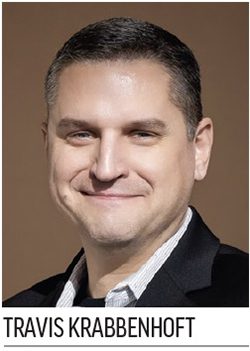 “We really took a ‘full-on’ approach,” says Travis Krabbenhoft, director of airport safety and SMS manager at DEN.
“We really took a ‘full-on’ approach,” says Travis Krabbenhoft, director of airport safety and SMS manager at DEN.
The comprehensive, long-term effort was validated in April, when DEN learned that FAA had accepted its SMS Manual.
The federal agency emphasizes safety management as a fundamental process to be considered in the same manner as other aspects of business management. It is the formal, top-down strategy that includes a systematic approach to managing safety, including the necessary organizational structures, accountabilities, policies and procedures.
DEN’s manual includes and reflects the official SMS pillars:
- Safety Policy: a commitment from leadership to integrate safety at all levels
- Safety Risk Management: systematic identification and mitigation of potential hazards
- Safety Assurance: continuous monitoring and improvement of safety processes
- Safety Promotion: training, communication and fostering a safety-first mindset
- Safety Culture: ensuring safety is a shared responsibility among all employees and stakeholders
System-Wide Approach
| facts&figures
Project: Developing & Implementing a Safety Management Systems (SMS) Manual Location: Denver Int’l Airport Umbrella Objective: Making safety an airport-wide priority Timeline: Initial policies & procedures were developed over 12 years; refinements will be ongoing; formal review via internal or external audits every Key Milestone: FAA acceptance of SMS Manual in April 2025 Software Platform: ProSafeT, from ProDIGIQ Cost: $250,000/yr. (not including staff costs) Tactical Tools: Anonymous reporting app; award tokens to acknowledge safe practices on the spot; quarterly safety bulletins (more if needed); stop-work authority for all employees |
Airport officials kicked off the SMS Manual development process by creating a unified safety team, consisting of members with diverse safety backgrounds, that reports directly to the executive office. “Our CEO (Phillip A. Washington) has been a great partner, making it a real core function,” says Krabbenhoft. “We don’t want to be a reactive safety system; we want to be a proactive safety system.”
This integrated effort covers both movement and non-movement areas of the airport, including occupational health, driver education and even other aspects not regulated by FAA.
While many in the industry talk about their “safety culture,” Krabbenhoft deliberately references the “safety climate” at DEN, and uses the analogy of a 100-year-old house to explain why.
“Safety culture is really the thermostat on the wall,” he says. “That is what your executives set the temperature of the room to be and say, ‘We’re going to make safety a function of our business; we’re going to integrate it in everything we do.’ Climate is what the actual room temperature is. And sometimes, when you live in a 100-year-old house, the number on the thermostat does not match the actual room temperature. The goal is to make that safety climate—the feeling for all employees—match what the safety culture given to us by our executive team.”
After conducting a gap analysis, DEN created an implementation plan. “As soon as that was approved by FAA, we started right away into writing our [SMS] manual,” Krabbenhoft says. “The manual has really been a collaborative effort where we tried to get all groups of the airport—both internal and external—to have a voice.” Building and fostering those communication paths helps ensure an inclusive operation in terms of establishing safety policies and procedures, he adds.
This approach involved groups the airport might not regularly work closely with and those outside the usual operational safety realm. “It gave us a good opportunity to have some open discussions and build some relationships,” Krabbenhoft says.
As DEN’s official accountable executive, Washington takes an active role ensuring the safety culture matches the safety climate, adds Krabbenhoft. “He makes sure everybody at all levels of this organization understands they have a right to work in a safe environment and how they can apply that to their job in a meaningful way to help drive that safety climate forward.”
Leveraging Technology
Finding the right tech tools early in the SMS development process was highly important to Krabbenhoft and DEN leadership. In fact, the airport procured safety software and then built policies and procedures around it, rather than the other way around.
In addition, the scope of work DEN issued required potential safety software to be compatible with the airport’s existing software. “We wanted a single source of truth for safety data and the ability to pull from our maintenance systems, airfield systems, everything we already had in place,” Krabbenhoft explains.
Documentation is an integral aspect of SMS, and for that, the airport relies on ProSafeT, from ProDIGIQ Inc. It is a comprehensive safety and risk management software platform designed to coordinate all collected safety data in a cohesive view, covering all five pillars of SMS and reducing the need to access multiple systems.
 By integrating safety data into ProSafeT, the airport is able to export trends and insights for predictive analysis. “This allows DEN to go from reactive to proactive,” says Anita Venkataraman, president and chief technology officer of ProDIGIQ. “Rather than chasing that information, they’re alerted about it and they can make actionable decisions based on the data they’re seeing as it is flowing through the process.”
By integrating safety data into ProSafeT, the airport is able to export trends and insights for predictive analysis. “This allows DEN to go from reactive to proactive,” says Anita Venkataraman, president and chief technology officer of ProDIGIQ. “Rather than chasing that information, they’re alerted about it and they can make actionable decisions based on the data they’re seeing as it is flowing through the process.”
DEN focused on integrating safety management into all airport operations, making it the heart of its ecosystem, says Venkataraman. “They wanted an SMS software that was mature and specifically tailored to the aviation industry,” she adds. “This would ensure that it encompassed any learnings and best practices from the airlines utilizing the system well before the FAA advisory for airports came into play.”
Venkataraman highlights DEN’s phased implementation as a successful strategy. Incremental go-live dates and training sessions allow airport users to gain a thorough understanding of the technology and its utility, she explains.
Revisiting and Rewarding Safety
Krabbenhoft notes that DEN conducts an inspection of its SMS on a three-year rolling cycle, using either an internal or external audit to “ensure that there are no holes.” This commitment allows the airport to continue working through processes and procedures for ongoing improvement. Keeping a strong risk register and following up on those risks in a meaningful and intelligent way is another big piece of the safety assessment, he adds.
Safety promotions or bulletins are sent out quarterly, with additional messages issued whenever a specific issue needs to be addressed. For 12 years, DEN has held an annual Safety Summit, where airport professionals from around the industry gather to discuss successful safety programs.
Acknowledging safe practices on-the-spot, as they occur has proved to be effective at DEN. Members of the Safety Team can award a Safety Award challenge coin to any worker who demonstrates a noteworthy commitment to making the airport a safer place. “That’s really helped drive this along,” Krabbenhoft reports.
A reporting app called See Say Airport also figures prominently into DEN’s overall program. Initially, it offered employees a way to anonymously flag security violations, but its use has expanded significantly over the last decade. Now, employees and passengers alike can use the digital tool to report anything from a leaky faucet or concessions issue to human trafficking and airfield safety concerns. Users can include photos, videos and GPS location information in text messages that are sent directly to airport authorities for investigation. “We’ve gotten a really good response from that—about 600 reports each month,” reports Krabbenhoft.
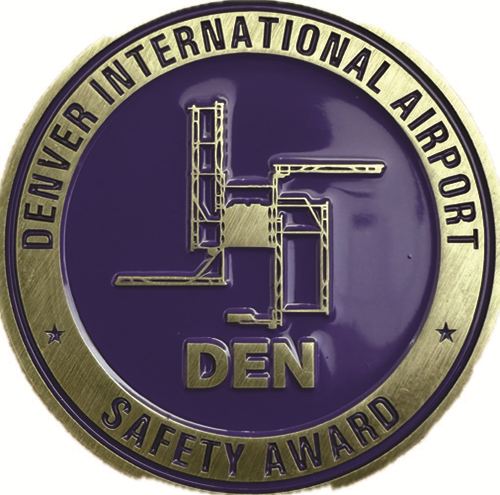 |
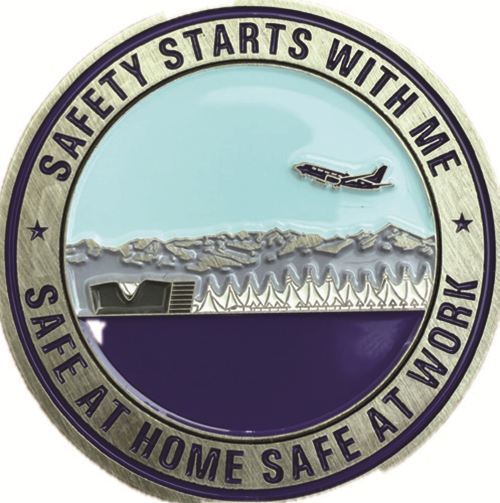 |
| The airport uses commemorative coins to acknowledge employees who show a notable commitment to safety. | |
In general, DEN works to elevate the “see something, say something” philosophy to “see something, say something and then do something.” The message to employees is, “If you can safely remove the hazard, remove the hazard, wipe up the spill, move the fuel cart. Do what is needed, and then let us know about it so we can track it from a larger, systemic perspective,” Krabbenhoft explains.
He also stresses open and honest communication. “It’s critical to be able to sit down, talk though issues, and ask what we can do better.”
Getting Buy-In
Krabbenhoft reports that the SMS team spent a lot of time meeting with senior leadership, directors, managers and supervisors to explain what it was trying to do and how they could help. “The real key is, if you have a team that’s big enough, send them out into the field and have them spend time with the different groups,” he advises.
To secure system-wide buy-in, he recommends sharing information frequently and in digestible formats. For example, DEN created a two-page summary of its thick SMS Manual for all stakeholders, complete with bullet points of the goals and most critical aspects.
Krabbenhoft also encourages other airports to make it easy for end users to file reports about safety concerns, and cautions against performing risk assessments in a vacuum. “Invite everybody to the table. Ask the questions,” he urges.
Because safety is an airport-wide responsibility at DEN, all employees have stop-work authority. “Any time anything feels weird, we want them to be able to pause the operation and ask the necessary questions,” Krabbenhoft explains.
He describes the SMS team as a robust group of employees who are “champions of safety.” A big part of their role is talking to coworkers to develop and promote practices and procedures that make the airport safer for everyone. One of their guiding goals is to create personal partnerships that help reduce risk vs. creating well-intended systems that actually don’t work for employees.
Krabbenhoft notes that among all of the successes, some industry-wide SMS challenges remain—particularly about data sharing and ensuring privacy. “How do we share information in a way that protects everybody, but we still get the meaningful data we need for our business to run properly? That’s one of the bigger things we’re still working through.”
One key takeaway from DEN’s experience creating an SMS Manual to serve everyone at the airport, is that it cannot be limited to Part 139 requirements. “Invite as many people as you can to the table,” Krabbenhoft relates. “Be very flexible and open to insight from other groups, other airports, on how they best do business. And always be willing to ask the question of ‘Why?’
“I think it’s incumbent upon the safety team to help everybody across the airport ask, ‘Can we do it a little bit different? Is there a safer way to do it?’”
Looking ahead, officials at DEN plan to expand safety training for employees and airport partners, as well as enhance the use of data analytics to proactively manage safety trends.
“The safety of our employees and passengers is the top priority at DEN,” says Washington. “I’m proud that DEN is a leader when it comes to safety policies and practices. We will continue to work alongside the federal government, major U.S. airports and airlines to share best practices and improve safety standards across the industry.”

